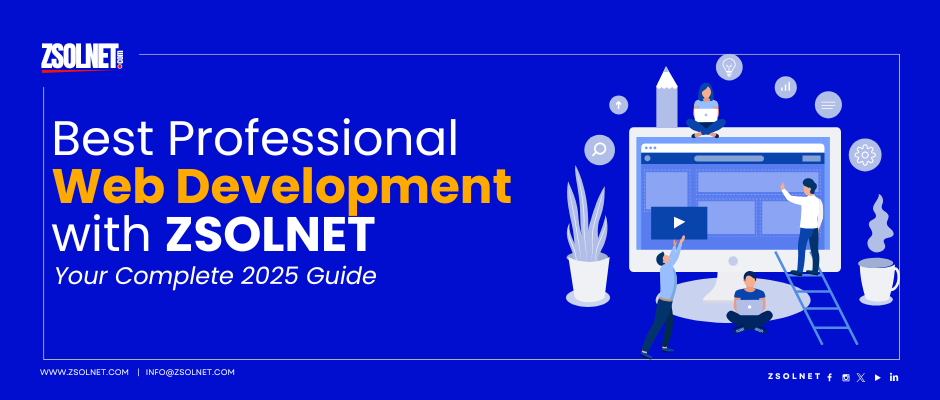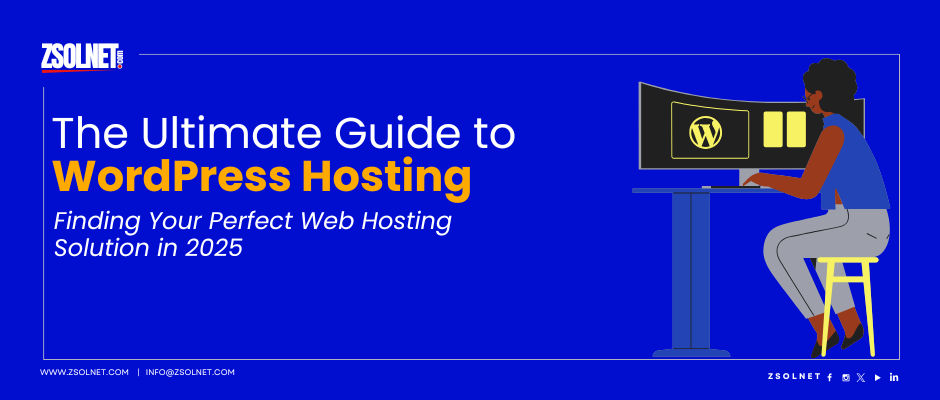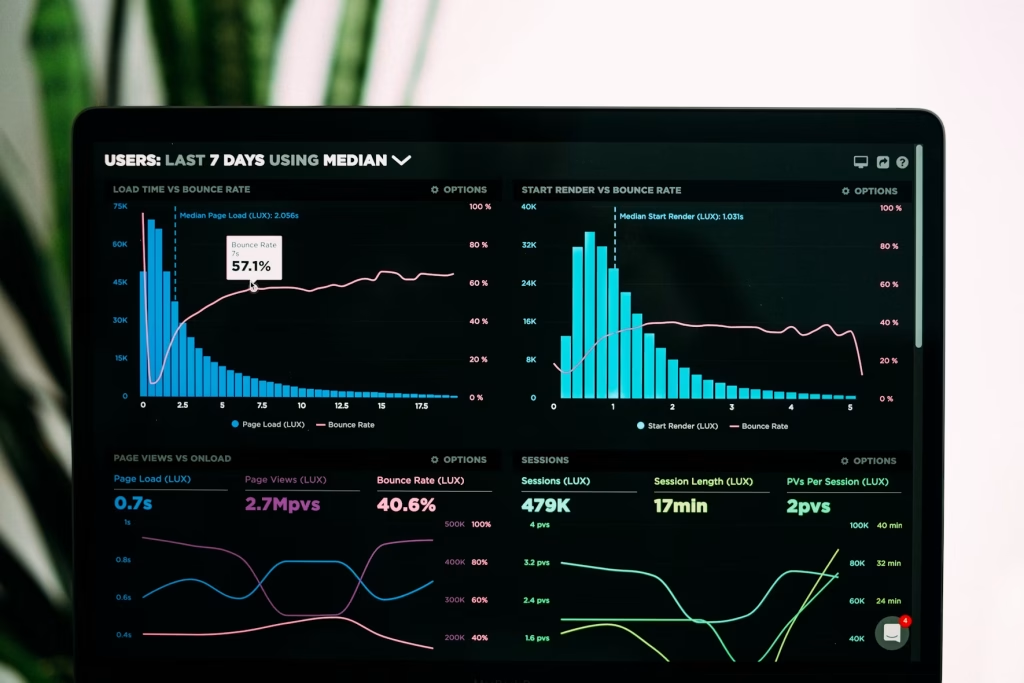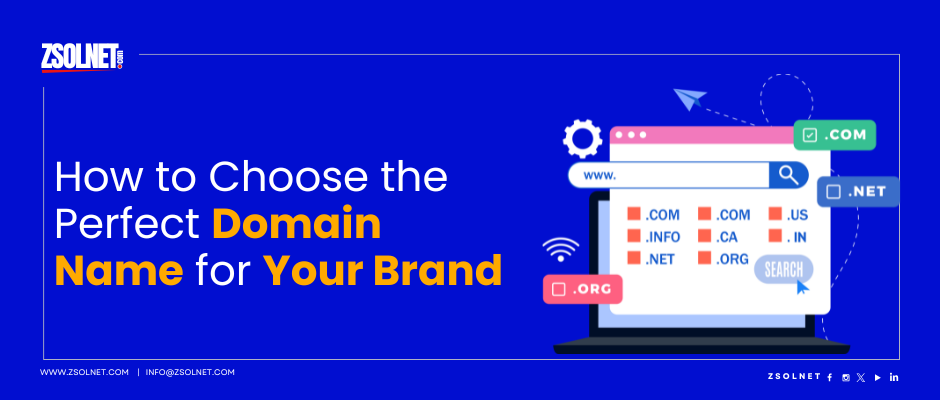Executive Summary
This comprehensive guide walks you through the process of creating a professional website with ZSOLNET’s expert web development and design services. Whether you need a personal website, business site, or full-featured eCommerce store, ZSOLNET provides professional web design and development tailored to your specific requirements. From understanding the importance of quality web design to learning the step-by-step process of working with ZSOLNET’s team to build and launch your site, this article covers everything you need to know to bring your online vision to life. ZSOLNET offers professional web development services, custom design creation, responsive website building, eCommerce functionality, and SEO optimization—all delivered by experienced developers and designers. By following this guide, you’ll be equipped to launch a website that not only looks professional but also performs exceptionally well for your business or personal brand.
Table of Contents
- Introduction
- The Importance of a Well-Designed Website
- Steps to Build a Website with ZSOLNET
- 1. Define Your Website Goals and Requirements
- 2. Schedule a Consultation with ZSOLNET
- 3. Collaborate on Design Concepts
- 4. Custom Development Phase
- 5. Content Integration
- 6. Implementation of Essential Features and Functionality
- 7. Search Engine Optimization
- 8. Thorough Testing
- 9. Website Launch
- 10. Ongoing Support and Maintenance
- Key Features of ZSOLNET
- Conclusion
Introduction
In today’s digital landscape, having a professional website isn’t just an option—it’s a necessity for businesses and individuals alike. Whether you’re launching a small business website, creating a personal portfolio, or establishing an eCommerce store, your website serves as your digital storefront and often forms the first impression for potential customers. However, the journey from conceptualizing a website to successfully launching it can seem daunting, especially for those without technical expertise. This is where ZSOLNET comes in, offering professional web development and design services for all website types. In this guide, we’ll walk you through the seamless process of bringing your website vision to life with ZSOLNET’s expert development team.
The Importance of a Well-Designed Website
Making a Strong First Impression
Your website often serves as the first point of contact between your brand and potential customers. Research shows that users form an opinion about a website within 0.05 seconds of viewing it. A professionally designed website instantly communicates credibility and trustworthiness, while a poorly designed one can drive visitors away before they even explore your content.
Enhancing User Experience
Website design isn’t just about aesthetics—it’s fundamentally about functionality. A well-designed website provides intuitive navigation, fast loading times, and mobile responsiveness, all of which contribute to a positive user experience. When visitors can easily find what they’re looking for, they’re more likely to stay longer, explore more pages, and ultimately convert into customers.
Boosting Search Engine Rankings
Search engines favor websites that provide excellent user experiences. Factors such as mobile-friendliness, page loading speed, and intuitive site architecture directly impact your search engine rankings. By investing in quality website design through ZSOLNET, you’re simultaneously investing in your search engine optimization (SEO) strategy, making it easier for potential customers to find you online.
Building Brand Consistency
Your website should be an extension of your brand identity. Consistent use of colors, fonts, imagery, and messaging across your website helps reinforce your brand and makes your business more memorable. ZSOLNET’s design tools make it simple to maintain this consistency throughout your entire online presence.
Steps to Build a Website with ZSOLNET
1. Define Your Website Goals and Requirements
Before starting the web development process, take time to clearly define what you want your website to achieve. Are you looking to generate leads for your business, sell products directly through an eCommerce platform, showcase your personal portfolio, or simply provide information? Understanding your goals will guide ZSOLNET’s team in creating the perfect website for your needs.
Action items:
- List primary and secondary objectives for your website
- Identify your target audience and their needs
- Research competitor websites for inspiration
- Determine what functionality your website requires (contact forms, payment processing, booking systems, etc.)
2. Schedule a Consultation with ZSOLNET
ZSOLNET offers flexible service packages designed to accommodate various needs and budgets. From basic personal sites to comprehensive e-commerce platforms, there’s an option that aligns with your requirements.
How to get started:
- Visit ZSOLNET’s homepage and click on the “Contact Us” button
- Schedule an initial consultation to discuss your project requirements
- Meet with ZSOLNET’s expert team to outline your vision
- Receive a detailed proposal tailored to your specific needs
3. Collaborate on Design Concepts
ZSOLNET’s designers will create custom design concepts based on your brand identity and requirements. These designs will serve as the foundation for your website’s look and feel. The collaboration process includes sharing your brand guidelines, reviewing initial wireframes, and providing feedback.
After the design is approved, ZSOLNET’s development team will build your custom website, ensuring it meets all functional requirements while maintaining design integrity. Key development elements include custom coding, implementation of the approved design, and integration of required functionality.
- Share your brand guidelines, color preferences, and design inspirations
- Review initial wireframes and provide feedback
- Evaluate design mockups created by ZSOLNET’s professional designers
- Approve final design direction before development begins
4. Custom Development Phase
Once your design is approved, ZSOLNET’s development team will begin building your custom website, ensuring it meets all your functional requirements while maintaining design integrity.
Development elements:
By understanding your needs, ZSOLNET allows you to focus on your business while they handle the technical details.
- Custom coding of your website structure
- Implementation of your approved design across all pages
- Integration of required functionality (forms, payment systems, etc.)
- Development of responsive layouts for all devices
- Setup of content management system if required
5. Content Integration
ZSOLNET can work with your existing content or help create new content optimized for both users and search engines.
Content development steps:
- Creation of essential pages (Home, About, Services/Products, Contact)
- Professional copywriting services if needed
- Strategic incorporation of relevant keywords throughout your text
- Addition of high-quality images and videos to enhance engagement
- Content organization for optimal user experience
6. Implementation of Essential Features and Functionality
ZSOLNET will implement various features to enhance functionality and user experience based on your website’s purpose. Popular features include contact forms, social media integration, and e-commerce capabilities with secure payment processing.
Popular features available:
- Contact forms and lead capture tools
- Social media integration
- Email newsletter sign-up widgets
- E-commerce capabilities with secure payment processing
- Booking and appointment scheduling systems
- Blog functionality for content marketing
- Analytics integration to track performance
7. Search Engine Optimization
ZSOLNET implements comprehensive SEO strategies to help your website rank higher in search engines, making it easier for potential customers to find you. This includes strategic keyword research and optimization of page titles and meta descriptions.
Action items:
List primary and secondary objectives for your website. Identify your target audience and their needs. Research competitor websites for inspiration. Determine what functionality your website requires (contact forms, payment processing, booking systems, etc.)
SEO implementation:
- Strategic keyword research and implementation
- Optimization of page titles and meta descriptions
- Proper heading structure setup (H1, H2, H3)
- Image optimization with appropriate alt text
- Creation of SEO-friendly URLs
- Implementation of schema markup where appropriate
- Mobile responsiveness optimization
8. Thorough Testing
Before launching, ZSOLNET conducts comprehensive testing to ensure everything works flawlessly across different devices. Testing includes cross-browser compatibility, mobile responsiveness, and loading speed optimization.
Testing process:
- Cross-browser compatibility testing
- Mobile and tablet responsiveness verification
- Form submission testing
- Payment processing verification for eCommerce sites
- Loading speed optimization
- Security testing
- User experience evaluation
Visit ZSOLNET’s homepage and click on the ‘Contact Us’ button. Schedule an initial consultation to discuss your project requirements. Meet with ZSOLNET’s expert team to outline your vision. Receive a detailed proposal tailored to your specific needs.
9. Website Launch
Once testing is complete and everything is working correctly, ZSOLNET will launch your website, ensuring a smooth transition to your live domain.
Launch process:
- Domain setup and configuration
- SSL certificate installation for secure browsing
- Final quality assurance checks
- DNS configuration
- Website deployment to live servers
- Post-launch testing
10. Ongoing Support and Maintenance
ZSOLNET offers ongoing support and maintenance services to ensure your website continues to perform optimally after launch.
Support services:
- Regular security updates
- Performance monitoring
- Content updates as needed
- Bug fixes and troubleshooting
- Feature enhancements and additions
- Regular backups
- SEO monitoring and adjustments
Key Features of ZSOLNET
Professional Custom Design
ZSOLNET’s team of experienced designers creates unique, visually appealing websites tailored specifically to your brand identity. Each design is crafted from scratch to reflect your business values and appeal to your target audience.
Design benefits:
- Custom designs created specifically for your brand
- User-centered design approaches
- Strategic placement of elements for optimal conversion
- Consistent branding throughout all pages
- Design that stands out from template-based competitors
Responsive Development
In an era where mobile browsing has overtaken desktop usage, responsive design isn’t optional. ZSOLNET develops websites that look perfect on any device, automatically adjusting layouts for optimal viewing experiences.
Responsive features:
- Mobile-first development approach
- Custom breakpoints for all device sizes
- Touch-friendly navigation for mobile users
- Accelerated mobile performance optimization
- Testing across all major devices and screen sizes
Custom Functionality
ZSOLNET’s development team builds custom functionality tailored to your specific business needs, going beyond what template-based solutions can offer.
Custom development capabilities:
- Bespoke feature development
- Integration with third-party services and APIs
- Custom database solutions
- Advanced filtering and search capabilities
- Specialized tools for your industry requirements
- User account management systems
Content integration is crucial. ZSOLNET can help create new content optimized for both users and search engines. Essential pages such as Home, About, Services/Products, and Contact should be well-structured.
E-commerce Capabilities
ZSOLNET develops powerful online stores with comprehensive eCommerce features. Whether you’re selling physical products, digital downloads, or services, ZSOLNET provides expertly coded solutions for a successful online business.
E-commerce functionalities:
- Complete product catalog management
- Multiple payment gateway integration
- Inventory tracking and management
- Tax and shipping calculations
- Order management system
- Customer account capabilities
- Product variants and options
- Discount and coupon systems
Advanced SEO Implementation
ZSOLNET integrates powerful SEO strategies into your website’s development, helping to improve your visibility in search engines and driving more organic traffic to your site.
SEO advantages:
- Technical SEO best practices built into the codebase
- Schema markup implementation
- Site speed optimization for better rankings
- Mobile optimization
- Clean URL structure
- Semantic HTML coding
- Structured data implementation
Domain and Email Setup
Establish a professional online identity with custom domain configuration and email setup. ZSOLNET handles all technical aspects of domain management for a seamless experience.
Domain services:
- Domain registration assistance
- DNS configuration
- Email account setup
- Domain transfer help
- SSL certificate installation
- Domain privacy protection
Analytics Implementation
Make data-driven decisions with properly implemented analytics. ZSOLNET sets up comprehensive tracking systems to help you understand your visitors’ behavior and continuously optimize your website for better performance.
Analytics capabilities:
- Google Analytics setup and configuration
- Goal and conversion tracking implementation
- Event tracking setup
- E-commerce tracking for online stores
- Custom dashboard creation
- Heat mapping tools integration
- User behavior analysis tools
Comprehensive Security Measures
Protect your website and visitor data with ZSOLNET’s comprehensive security implementations, including SSL encryption, regular backups, and malware protection.
Security highlights:
- SSL certificate implementation
- Secure coding practices
- Regular backup systems
- DDoS protection setup
- Security headers configuration
- PCI compliance for e-commerce
- Regular security audits
Conclusion
Building a website with ZSOLNET means entrusting your online presence to experienced professionals. Their team’s technical expertise, attention to detail, and focus on user experience make them an ideal choice for all website types.
Whether you’re a small business owner or an individual showcasing your portfolio, ZSOLNET’s web development and design services will help you create an outstanding website. Ready to bring your vision to life? Contact ZSOLNET today to schedule a consultation.
Ready to bring your website vision to life? Contact ZSOLNET today to schedule a consultation and discuss how their web design and development team can create the perfect website for your specific needs. Your professional online presence is just a call away.
Transform your ideas into a stunning, functional website with ZSOLNET – where professional web design and development expertise meet your unique business requirements.




